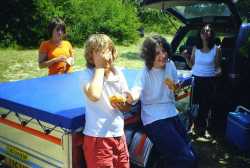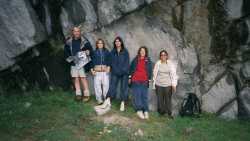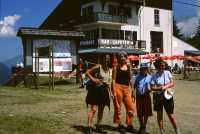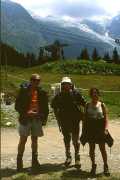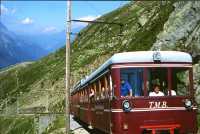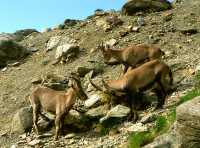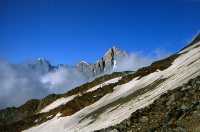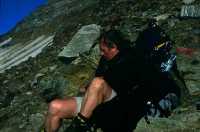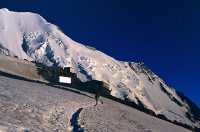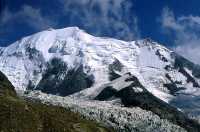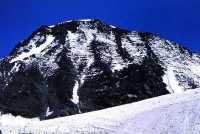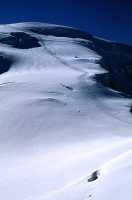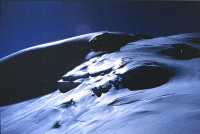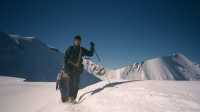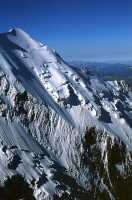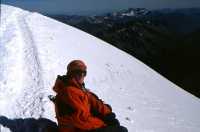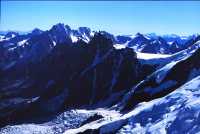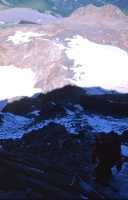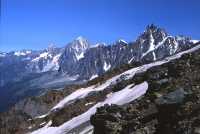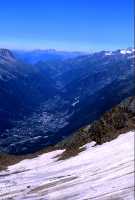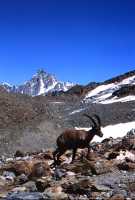| Chamonix 2002 - 1 | |
| Saturday 20th July
Sunday
Monday
Tuesday
|
That
evening, we had a little walk round Chamonix. Alice spied a walking guide
in Tairraz’s window. The town had changed a lot in 30 years - all
pedestrian precincts, the Bar Nat now a tarty restaurant and, worst of
all, the Alpenstock a MacDonald’s! Where climbers go for a drink these
days I don’t know, or perhaps they don’t. That
night there was an impressive thunderstorm. We lay in our sleeping bags
listening to the crash of lightning on the Aiguilles - virtually no delay
between the flash and the crack. Heavy rain - many grumblings from Alice,
but the children didn’t seem worried. Angela was sleeping in her own
little tent and got a bit damp with no flysheet.
We
went into town and were surprised to find all the shops open. I bought two
walking guides at Tairraz’s.
Paul
and I, rashly not deigning to take the rack railway to the Nid d’Aigle,
set off up the easy, but precipitous, path on the valley side of the
ridge. In the We
soon left the path and got back onto the railway track at a col by an
abandoned station, from here on it was a constant angle slog along the
track. The piggish attitude of descending walkers gave a hint of horrors
to come. By the time I reached the Nid d’Aigle I There
was no water, but there were a lot of tourists, and to our surprise a
whole group of Chamois or some other sort of mountain goat (in fact they
were bouquetins, not Chamois as I have recently been informed). They were not
at all shy and came right up to be photographed - probably After
an age I could see Paul at an abandoned hut (marked as a It’s
no good, I said, I’ll never make it. Another long discussion, the
problem with bivouacking was not having any water, apart from the comfort
aspect. Finally Paul offered to carry my rucksack if we continued to the
refuge. Such heroism could not be ignored and, without the load, I plodded
on, Paul in front with my sack on top of his - he must have had a good 40
kgs! The path soon steepened and zigzagged up the rock buttress. After a
bit, I took the ropes and Paul got my sack in front, with his behind and
slowly we made our way to the hut, which we finally reached after crossing
some slushy snow just as the sun was going down. We
had, as one must do systematically these days, reserved our places by
phone and, fortunately, the guardian had not given them up to anyone else
despite our late arrival. At
10h30 we bade him goodnight, found the places reserved for us, and went to
sleep. It was clear that the Aiguille de Bionnassay was out of the question
given my state, even Paul was not feeling that good. We had not had time
to suss out the route to take in the dark next morning either. If we
couldn’t get up, reversing an ice climb did not seem a very attractive
proposition. The idea of traversing Mont Blanc to the Midi was also quite
obviously ridiculously ambitious - we were brought back down to reality
with a crunch. We had decided to see how we felt in the morning, and
perhaps go up to the Aiguille de Goûter with the lightest of sacks along
with the crowd headed for Mont Blanc at 2 in the morning - at least we
would get to the top of something. The guardian had been grumpily
negative; saying the best thing we could do was go back down to the
valley. It
was nice to be warm under blankets on the collective wooden bunk typical
of alpine huts, much better than shivering in a windy bivouac lower down -
I certainly owed Paul for that, and despite the grunting and snoring I was
soon asleep. I was woken by the headlights of the other climbers getting
ready to leave for Mont Blanc by the Aiguille de Goûter route. I looked
at my watch: 2 o’clock. I felt wide-awake and a lot better, strangely
keen to get going. Paul was less enthusiastic, but I wanted to be off
early to have enough time spare in case I was going as slowly as the day
before - besides, there was a brilliant full moon and climbing by it’s
light appealed. I bought a litre of hot water from the guardian, and paid
the bill. He was as gruff as before and when I announced our plans to head
off up, just tutted in a scornful way, “dangerous up there” he grunted
with a look that made clear his view of our competence, or, rather, the
lack of it - normal communication was impossible. I got Paul out of his
slumbers with promises of coffee and we had breakfast amidst the bustle of
the excited preparations of the other groups. We
were soon left alone; we weren’t really in a hurry as we only intended
to do the Aiguille de Goûter and not Mont Blanc. The guardian asked if we
had lamps, to which we replied in the affirmative, puzzled by what seemed
an uncharacteristic concern on his part. The reason was soon obvious as he
switched off all the lights and went back to bed. By the time we realized
that the hut worked to a preordained program - lights on at 2 for Mont
Blanc, then off again till 7 for the next session - he had disappeared
into his lair and we realized that we had not purchased water for the day.
Light could still be seen under the door so I knocked gently to ask for a
bottle of the pricey commodity. The only result was a click as he turned
off his light and then silence - he knew what we wanted - my French is not
that bad - but he had clearly decided we were not worth bothering about. I
later spoke to a young French climber about this surly attitude and he
replied that it was like that on Mont Blanc; the route is so frequented
and the huts so full that attitudes are far less friendly than elsewhere.
I am sure that unguided climbers who don’t pay for meals are looked down
upon too - not a nice mentality and quite different to that of my last
visit, admittedly 30 years before. I was later to meet a French climber,
even older than me, though he certainly didn’t look it, who confirmed
that there had indeed been a change of attitudes over the last 10 or 15
years - of which more anon. Well,
coming back to this other representative of Gallic hospitality, I just
thought, “sod him”, we packed light day sacks, with practically no
gear and just a single rope, which, in fact, we didn’t need, and I went
out the door into the moonlight. I sat there waiting for Paul, warm as
toast in a duvet and anorak, and in a semi-somnolent state admired the
dark mass of the West side of the Aiguille de Goûter above us. It is in
fact a huge heap of rubble; several slightly pronounced dark buttresses
separated by lighter couloirs - normally snow filled, but this year nearly
dry in their lower reaches - perfect stone shoots. Little lights twinkled
all the way up as the early risers climbed steadily up, the wind had
dropped and it seemed all very peaceful; more like fairy land than one of
the most deadly spots in the range. This deadliness is due to the sheer
number of people and the attraction the mountain has on relatively
inexperienced climbers, plus the infamous crossing of the Grand Couloir we
were soon to come to. We
got off by about 3 o’clock, taking our time plodding up the snow slope
below the face in crampons. The torches were hardly necessary on the snow
as the moon was nearly full. We used them more when we reached the rocks
and the first of the fixed cables. Soon we reached the Grand Couloir; in
fact we had just been following the others and had not realized where we
were exactly. Paul had done the climb alone 18 years before but hadn’t
recognized the way up at all, apart from the bit along the railway track.
The couloir is crossed by a cable that normally one can clip into for
protection, but the cable was about 15 feet above our heads, completely
out of reach. The reason is that although it was still only July, the
weather had been relatively hot and dry and the snow couloir was now just
a scoop of gravel, snow higher up, a few patches of ice amongst the rocks
lower down, with a stream running down the middle. The danger is the
frequent stone fall caused partly by melting snow higher up, partly by the
water, but also by the numerous parties The
trick is to wait for the next stone fall, then as soon as it’s finished,
nip across smartly. We weren’t roped up and had already taken our
crampons off, it probably would have been best to keep them on as there
were ice patches where the water was coming down, but with ice-axe in hand
we crossed one by one without mishap. The quandary, discussed in great
length in newsgroups, is whether to rope up, the problem being that the
couloir is wider than a rope length, and so a belay is not possible.
Moving together is equally problematic as anything that slows one down
increases the danger, and it’s On
the other side the way was steeper, but still well marked and well endowed
with cables. In the dark we clipped into these on occasions, thus avoiding
roping up. The situation was superb; in the darkness the chossy nature of
the face was hidden and below us the valley was full of lights. During our
frequent stops we amused ourselves by picking out forms in the street
lights, a bit like making up constellations in the stars above; even if
the climbing was just a scramble the situation was magnificent, it had
certainly been well worth getting up for. I mused about the fact that the Breakfast
tasted good, and the view was excellent. The hut is only 50 metres below
the We
just dawdled along taking photos and admiring the views, really pleased
not to have heeded the grumpy guardian’s advice. Finally, we thought we
had better be off as we didn’t fancy another night in a refuge, and,
anyway, we hadn’t booked. On the subject of reservation, the Goûter hut
is apparently permanently fully booked; you have to phone days or even
weeks in advance - in an area renowned for its unstable weather. This must
in itself lead to accidents, as parties who have managed to book a place We
were soon headed for the valley, past the hut and down the buttress,
continually passing people coming up or down or being passed by others who
didn’t exactly push but weren’t far off. We soon arrived above the
Grand Couloir where we had an illustration of the danger. Some parties
really took there time crossing; only hurrying when the cry of “pierres!”
went up from those watching. One group of three, Ukrainians or Russians
judging by their accents, crossed closely roped together when a whole load
of rubble came down. Hindered by their ropes they only just managed to
escape, the last one took quite a blow on his rucksack. We didn’t hang
about, and nipped across as nimbly as we could. Just in front of me, a
climber slowed down by his huge back-pack, chose the most dangerous spot,
in the middle of the stream, to stop and ask his companions for guidance,
I managed to jump past quickly, cursing myself At
the Tête Rousse refuge we picked up the gear we had left, bade farewell
to the miserable guardian and his equally dour crew, one of whom took
evident pleasure in confirming that there were no dustbins and we had to
take “our” rubbish, as opposed to “their” rubbish if we had
purchased their own wares, down to the valley - what an unpleasant lot
they were! The path seemed easier going down than up, the air was getting
tangibly thicker all the time, but it was still a long trog. The monotony
was broken by stopping for mackerel sandwiches and chatting to those on
the way up. One young couple were particularly refreshing; they had had to
walk up from Bellevue, like us, as the train had broken down, they
hadn’t been able to book into a hut - already full - and, though they
had no tent, weren’t a bit worried, they’d sort something out. We
dropped down past the abandoned hut and its unhygienic surroundings -
clearly many had slept there but few had thought about the long-term
results of their nocturnal excretions! The path was easy but tiring, going
down doesn’t strain the same muscles as going up and we began to wonder
about train times - hoping they were running again and that we wouldn’t
have to wait too long. There were even more bouquetins to be seen than the
day before - the plaintive cries of a young one calling it’s mother was
particularly eerie. We
saw a train pulling into the station when we were still quite a long way
off and somehow found the energy to speed up in the hope of getting on;
the closer we got the tenser I felt, surely it would pull out before we
got there. It’s strange how tiredness and lack of oxygen make the minor
inconvenience of having to wait a The
next stop was Les Houches, a short stagger uphill to the téléphérique
station, more completely futile anxiety while buying tickets, it wasn’t
late and if you miss one there’s another a few minutes later. Lack of
sleep made me worry about everything, but we were soon down in Les Houches
and that oft felt relief of being off the mountain came at last, spreading
through the body like hot soup on a cold day. A beer, or two, in a café
finished the transition while waiting for the free bus back to Chamonix:
things had finally worked out as well as we could have hoped, and
certainly a lot better than I might have supposed the evening before! Once
in Chamonix, a quick phone call and Alice came from Les Praz to pick us up
and we were back at camp for dinner. The others had been up to the Brevent
by téléphérique, followed by a long walk, with Angela guiding the party
and William running ahead to scout the path. I slept well that night. Revised 24/04/2014 |
| <---- |
